Baby Care & Parenting Blogs

Top Benefits of Choosing a Pashmina Baby Blanket for a Li...
On cold winter days, babies need extra protection and comfort to stay warm and cozy. The chilly air and dropping temperatures often make parents more cautious about how to keep their little ones snug, safe, and comfortable. The absolute core to every parent's desire is the comfort and safety of their little child. From that first cuddle to the initial nap, babies are meant to be surrounded by soft, gentle surroundings filled with care. While there may be a long list of winter essentials for newborns, when it comes to sleep and rest, the baby blanket for winter is definitely the key element. Many alternative options are available, from fluffy fleece to everyday cotton blankets; a special few stand out for their luxurious feel and superior benefits.
Among the very best are blankets made from natural, breathable, and truly luxurious materials like pashmina. These are not just blankets; they are a warm-hearted hug, a protective shelter for the little one. What makes a pashmina blanket such a special choice? Let us look into how this rare material really goes a long way towards enhancing a child's comfort.
Why Choosing the Right Blanket Material for Babies is Important
Baby skin is very delicate and sensitive. Since a baby blanket touches the skin directly, the right fabric for a newborn’s blanket becomes especially important. A wrong choice may lead to skin irritation, rashes, or sometimes even allergies. That is why most of the parents are in favour of natural fibres over synthetic ones.
Another factor to consider is breathability. Sweating and uneasiness may be caused in babies by a blanket with poor ventilation. Allowing air to pass through helps maintain a baby's body temperature and supports restful sleep. This is especially crucial because babies cannot regulate their own temperature like adults do.
When a natural and safe alternative like pashmina wool is chosen, it is not simply buying a blanket; it is investing in well-being for the little one. It’s a choice that prioritizes their health, safety, and comfort above everything else.

Why the Somya Aanchal Towel Makes Bath-Time Special for N...
Bath time is one of the most joyful and bonding moments for parents and babies. It is not just about cleansing, but also about laughter, play, and the closeness that builds trust. For many families, it becomes a cherished daily ritual filled with warmth and affection. Yet, what follows the bath is just as important as the bath itself. A baby towel becomes the first layer of comfort after water touches delicate skin. Soft and clean baby towels wrap the baby in protection, keeping their body warm, dry, and cared for. This is why a newborn baby towel is not just another add-on for the shelf but an essential part of baby care. What seems like a daily task becomes a soothing ritual with a soft, absorbent towel for comforting fragile skin and deepening the bond between parent and baby.
Bath Time Needs Extra Care. Here’s Why
A baby’s skin is soft, sensitive, and loses moisture faster than an adult's. In such a case, the towel’s fabric plays a crucial role in keeping it protected and gentle. A rough and poor-quality towel could give rise to irritation or redness on the baby's skin. That is why soft baby towels are always recommended, as they play a key role in keeping a little one’s skin safe and comfortable. It brings the idea of safe towels where comfort, softness, and absorbency would meet under one roof to dry the baby quickly and gently after every bath.

A Parent’s Go-To Guide for Safe and Comfy Baby Swaddling
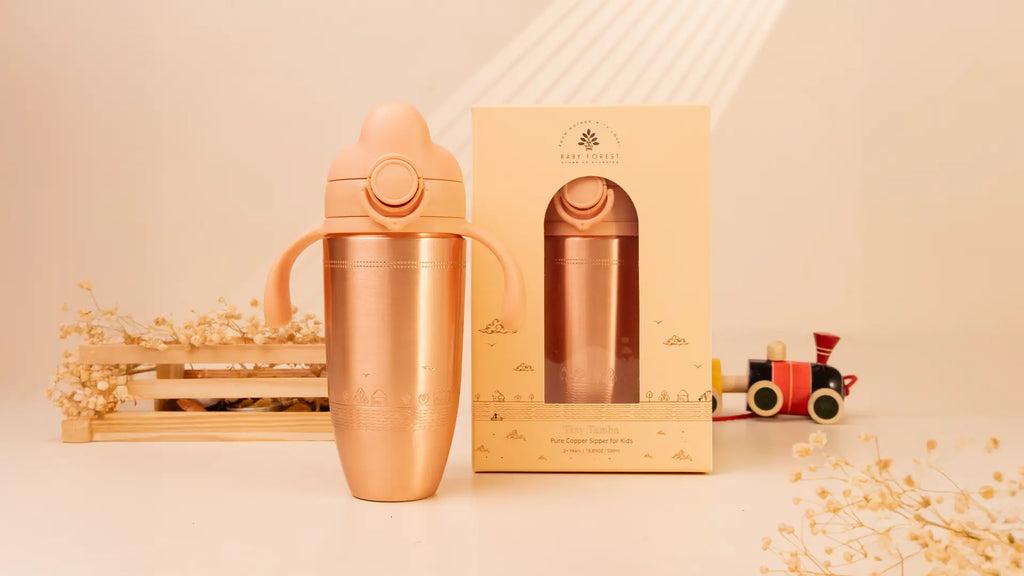
Why Copper Is Essential in Your Child’s Daily Routine
Parenting is a journey full of choices and mindful decisions. Among these choices, one topic that has gained attention is the use of copper bottles and sippers for kids. Many parents want to know whether this traditional practice still holds value in today’s modern world. The truth is copper vessels are not a passing trend, but they have been part of Indian households for generations.
Have you ever thought about why our grandparents used to store water in copper vessels? Copper bottles and sippers are currently returning to daily life as more families choose to live a natural and toxin-free lifestyle. In this blog, we will see why copper bottles can be a safe and healthy choice for children, what benefits they bring, how to use them properly, and the simple cleaning practices that every parent should know.;
Why Choose Copper for Kids?
Kids are more sensitive than adults. Their bodies are still developing and they absorb nutrients at a faster rate. This is why parents often look for safer alternatives to plastic bottles, which may contain harmful chemicals. Copper is a natural element that stands out as a safer and healthier choice.
Moreover, copper is known for its antibacterial properties. When water is stored in a copper vessel, it goes through a natural purification process. Harmful bacteria are killed and the water becomes safer to drink. For kids who are prone to stomach infections and low immunity, using a copper vessel is considered a natural way to reduce risk without adding artificial chemicals.
Unlike plastic, copper bottles do not release toxins when exposed to heat or sunlight. They are durable, eco-friendly, and align with the idea of raising children in a natural environment. Parents who are conscious about sustainable living also find copper to be the right choice for their little one.;
The Health Benefits of Drinking Water from Copper Bottles
Copper is not just a material, it is also an essential mineral required by the body. When water is stored in a copper bottle for a few hours, tiny amounts of copper dissolve into it, making it naturally infused with this mineral. Therefore, drinking water regularly from copper sipper can offer a lot of health benefits:

-
Boosts Immunity
Copper has antimicrobial and antioxidant properties that help strengthen the immune system. Children who drink water that has been stored in copper bottles are less prone to common diseases like stomach infections, seasonal flu, cough and cold.
-
Supports Digestion
One of the oldest known benefits of copper water is its role in improving digestion. It can stimulate the production of digestive enzymes and reduce problems like acidity and gas, usually common in children.
-
Aids Brain Development
Copper is essential for the formation of myelin, the protective sheath around nerves. This supports healthy brain development and improves focus and learning abilities in growing kids.
-
Promotes Strong Bones
Copper helps in the absorption of iron and is beneficial to bone and joint health. For children, this leads to stronger bones and better growth.
-
Maintains Healthy Skin
Copper is known for its role in collagen production, which keeps skin soft and healthy. Kids who drink water from copper bottles have more healthy and glowing skin as compared to other.
-
Balances Energy Levels
Since copper helps regulate thyroid function and energy metabolism, it can support children in staying active and energetic throughout the day.
*Myelin: It is a protective fatty layer that wraps around nerve fibers. It helps speed up the transmission of signals between the brain, spinal cord, and body.
Are Copper Bottles Safe for Children?
The most common question parents ask is whether copper bottles are safe for kids. The answer is yes, but with some important points to remember. Children only need trace amounts of copper and water stored in copper bottles naturally provides this in small doses. That is why it is recommended to use copper bottles in moderation.
Here are a few safety guidelines:
- Store water in the copper bottle for 6 to 8 hours before drinking. Overnight storage are more beneficial.
- Do not store acidic drinks like juices or milk beverages in copper bottles, as they can react with the metal.
- Always fill the copper bottle with fresh, filtered water to ensure purity.
How to Introduce Copper Bottles to Kids
Using copper bottles or sippers may feel unfamiliar to your child if they are used to drinking water from plastic bottles. Encourage your child to drink water from a copper sipper once a day, preferably in the morning. Children are naturally curious, so you can explain to them that this is “magical tonic” that makes them stronger and healthier.
Make them habituated to drinking water from copper sipper by slowly introducing them in small sips. This way, children will be more excited to use it regularly. Slowly, drinking copper-infused water can become a daily habit without any struggle.
Cleaning and Caution for Copper Sippers
Copper needs a proper care. Unlike plastic or steel, copper can oxidize and develop a dark layer over time. This is natural and does not mean the bottle is damaged, but it does need proper cleaning.

Here are a few easy cleaning tips for parents:
-
Lemon and Salt Method
Cut a lemon in half, sprinkle some salt on it, and rub it inside the bottle or sipper. This will remove stains and restore shine. Rinse thoroughly with water afterward.
-
Tamarind Paste
Tamarind is another natural cleaner for copper. A gentle rub with tamarind paste can clean the surface easily.
-
Avoid Harsh Cleaners
Do not use chemical dishwashing liquids or steel scrubbers. They can damage the copper and reduce its durability.
-
Regular Rinsing
Always rinse the sipper or bottle with plain water before refilling it. This helps keep it fresh and safe for kids.
Note:
- Never use copper bottles for milk, fruit juices, or carbonated drinks.
- Do not leave water in the copper bottle for more than 24 hours.
- Check the sipper regularly for dents or cracks. If damaged, it should be replaced.;
Choosing the Right Copper Sipper for Kids
Not all copper bottles are made the same. When choosing one for children, you should keep a few things in mind:
- Size and Weight: Pick a sipper that is small and lightweight, making it easy for little ones to hold and carry around easily. Children might not be able to handle a heavy bottle.
- Design: Choose a design with rounded edges and a simple, child-friendly shape. This ensures safety while drinking and makes the sipper comfortable for tiny hands to grip, encouraging independence with everyday use.
- Quality: Make sure that the sipper is made from pure copper and not mixed with other metals. Pure copper brings several health benefits associated with the metal, while mixed or low-quality bottles may lose effectiveness and compromise safety.
-
Lid and Spout: A spill-proof lid and a smooth drinking flow are the most important features to be mindful of. These not only prevent unnecessary mess but also make it easier for kids to drink comfortably, whether at home or school.
Conclusion
Children's copper sippers and bottles are more than just water bottles; they are a blend of tradition, health, and mindful parenting. While modern options think plastic and steel bottles are easy to use, copper stands out for its natural antibacterial properties and nutritional benefits. Copper water should be given in the right amount, and bottles should be cleaned properly to keep them safe. Copper sippers can become a reliable part of a child's everyday routine with the right approach. In a world full of artificial choices, sometimes the simplest and most natural solutions turn out to be the best.

Everything You Need to Know About Newborn Sleep Patterns
Did you know one of the biggest challenges for new parents is understanding their newborn’s sleep pattern? Unlike adults, babies don’t sleep in long, predictable stretches, and that can feel overwhelming at first. Sleep for newborns follows a natural rhythm that develops over time, and that rhythm is what we call sleep patterns. These patterns are based on age, feeding needs, and overall development. They might feel random at first, but there is a structure behind it. Once you understand how sleep changes over time, it becomes easier to manage expectations and respond in the right way. Let's break down how baby sleep patterns by age typically look, what to expect, and how to support your baby's rest through helpful routines.
Sleep Requirements by Age: A Parent’s Guide
The sleep needs of a baby change quickly in the first year. All of these changes are important to track because sleep directly affects growth, mood, and development. If you're trying to understand baby sleep patterns by age, start with this breakdown of what sleep usually looks like across key stages.
Sleep Needs Of a 0 to 3 Month Old
In the first three months, there is no fixed sleep schedule. Babies at this age can sleep anywhere between 14 to 17 hours in a 24-hour period. But this sleep is spread out over short stretches, sometimes only 2 to 4 hours at a time.

At this stage, day and night don’t mean much to a newborn. Their circadian rhythm (body clock) hasn’t developed yet, so it’s normal for them to sleep more during the day and be awake at night.
Moreover, waking up often is also expected. Newborns wake to feed, to be changed, or simply because their sleep cycles are short and light. Crying, moving in sleep, and even brief waking between sleep cycles are all common.
Sleep Needs Of a 4 to 6 Month Old
Around four months, baby sleep patterns start to become a little more regular. The internal body clock, or circadian rhythm, begins to mature. This means your baby starts to learn the difference between day and night.
Sleep stretches at night may get longer. Some babies can sleep for five or six hours without waking. During the day, naps might become more regular, usually two or three naps spaced out between feeds.
Additionally, a four-month sleep regression comes in, which is a normal phase where your baby’s sleep suddenly changes. They may wake up more often at night, take shorter naps, and seem fussier than usual. This happens because their sleep cycles are maturing. While it can be exhausting, it’s a sign of healthy development, and it will pass.
Sleep Needs Of a 6 to 12 Month Old
Nap Time Tips For Parents
Naps are just as important as nighttime sleep. They help babies rest, grow, and manage the world around them. But naps can also be hard to manage. A key part of supporting baby sleep patterns is knowing when and how your baby prefers to nap. Instead of forcing a set nap schedule, it often helps to watch for signs of sleepiness. These signs can include rubbing eyes, yawning, losing interest in surroundings, or turning away from faces.
Try to keep nap times in a calm space. Dim lights, soft noise, and a familiar spot, such as a crib or cot, can help. A soft, breathable surface like the Baby Forest Baby Sleeping and Changing Sheet makes nap times more comfortable while also ensuring hygiene, since it doubles up as a changing sheet. Avoid making every nap happen in motion, like in a stroller or car. If a baby only naps when being rocked or driven around, it can make it harder to build regular patterns later.
It's also important to avoid skipping naps. A common mistake is thinking that less sleep during the day will lead to better sleep at night. Usually, the opposite happens. An overtired baby may find it harder to fall asleep.
Bedtime Routines For Babies
A steady bedtime routine plays a key role in shaping healthy baby sleep patterns. Repeating the same steps each night helps babies understand that it's time to sleep. But often, small details go unnoticed, and these can make a real difference. The routine itself can be simple, like a warm bath, a short feed, a lullaby, dim lights, and quiet time. What matters is doing it in the same way, at the same time, every night. Here are a few things parents often miss:

- Lighting: Bright or cool-toned lights can confuse a baby's body clock. Stick to dim, warm lights in the evening.
- Noise: Sudden sounds after the baby is asleep can wake them. You can use gentle white noise to block out sounds, but use it on low volume and only when needed.
- Clothes: Itchy fabrics or tight clothes can disturb sleep. Choose soft, breathable sleepwear that your baby can sleep in comfortably.
- Screens: Avoid using phones or screens during bedtime. Even indirect light can affect sleep readiness.
- Timing: Don't start the routine too late. If the bedtime routine starts too late, an overtired baby may find it harder to fall asleep.
- Too many steps: Keep it short and clear. A routine that's too long can become confusing.
- Parental stress: Babies can sense tension. Try to maintain a calm and slow-paced mood while putting the baby to sleep.
Tips for Creating Consistency
Babies do not need a perfect schedule, but they do benefit from consistency. Consistency helps them feel secure. It also supports better baby sleep patterns by age as they grow.
- Try to keep naps and bedtimes at roughly the same time each day. You do not need to follow the clock closely, but having a rhythm helps. Babies thrive when they can predict what happens next.
- Use the same sleep space whenever possible. A dark room with soft white noise or a fan can make a good sleep environment. Avoid moving between too many sleep settings, as this can confuse the baby.
- Feeding is another part of sleep. If your baby always feeds to fall asleep, try slowly adding other calming methods too, like gentle rocking or soft singing. Over time, this helps your baby learn to fall asleep without always needing milk.
- You can also keep a loose sleep log. Even just writing down nap times for a few days can help you see patterns more clearly.
Conclusion
Baby sleep patterns are not fixed. They shift from one stage to the next. What works one month might stop working the next. This is not a problem; it's just part of how babies grow.
By understanding baby sleep patterns by age, you can respond in a way that supports your baby's natural needs. Some days will be smooth, others won't, and all of this is very normal. There is no perfect method for getting babies to sleep. With a steady routine, gentle cues, and patience, your baby will gradually find a sleep rhythm that works for them and so will you.

5 Ways A Mustard Seed Pillow Benefits Your Newborn's Comf...
The early months of a baby’s life are marked by frequent naps and long stretches of sleep. It is during these naps that the baby's neurodevelopment* takes place; the body actually grows, and posture begins to form. The kind of support provided during sleep has much to do with comfort and healthy development.
For centuries, families have used a mustard seed pillow as the very first pillow for newborns. This small, yet powerful pillow differs from a cotton pillow. It slowly adjusts to the shape of the baby's head, supports the baby's neck, and keeps it cool. It helps prevent flat head syndrome, improves blood circulation, and creates a relaxed environment for sleeping.
A mustard seed baby pillow is more than just a bedding accessory. A blend of tradition, natural care and gentle support that continues to be trusted even today. Let’s look at five ways a rai pillow for a baby adds comfort and health to a newborn’s early months.
How Head Shaping Pillows Make a Difference
Provides Natural Head Shaping
When babies sleep, their heads rest in the same position for long hours. Since their skulls are soft, they tend to develop flat areas. A mustard seed pillow prevents this by adjusting itself to the baby's head shape. The tiny seeds gently shift to fill any gaps and balance pressure on all sides of the baby's head. This sort of natural support keeps the baby’s head in shape. Caring for the baby in this way prevents flat head syndrome and makes for safe and comfortable sleep. It feels like a gentle cradle on the head every time the baby lies down.
Improves Blood Circulation
A balanced blood circulation is of utmost importance for a baby’s growth and comfort. The mustard seed baby pillow gently adapts to the baby’s head instead of staying rigid, preventing pressure from building up in one spot. The continuous micro-adjustments lower pressure at any single point, allowing equal blood flow through the scalp. This promotes healthy hair growth and nourishes the skin. With smooth circulation, the baby feels relaxed and falls into extended spells of sleep. The pillow becomes more than just a support, it works gently by supporting the baby’s tiny body and taking care of them while they rest.
Supports Neck and Spine Alignment
Neck and spine support is just as important as head support for a newborn. Babies cannot hold their heads yet, so they require help in maintaining a correct posture. A rai pillow for a baby provides that support naturally. When the baby moves, the mustard seeds adjust themselves to keep the head and neck evenly positioned, maintaining spine alignment and preventing unnecessary strain. With the right posture, babies can sleep well and wake up refreshed. It is a simple routine of taking care of the baby’s body through the most delicate days of development.
Keeps Baby Cool and Comfortable
Babies often get warm quickly while sleeping, especially in hot or humid weather. Regular pillows trap heat, making them restless. A mustard seed pillow freely permits air circulation through the seeds, so there is no heat buildup. Natural ventilation keeps the baby cool, dry, and sweat-free. When babies sleep comfortably into a deep sleep, they are less likely to wake up. For parents, this is another gentle way of nurturing their baby's comfort so that each nap is soothing even on a warm day. It creates a cosy space where babies rest with ease.
Creates Relaxation and Comfort
For newborn babies, sleep isn’t just physical; it is also something emotional. And a mustard seed pillow provides both. Mustard seeds give the right amount of support needed to relax a baby's head. Its softness, along with gentle fabrics and herbs like lavender, helps the baby feel calm and relaxed. Lavender keeps mosquitoes away, hence providing a peaceful sleep. This combination reduces fussiness and helps babies settle more quickly. As a parent, watching a baby rest comfortably also helps give calm assurance to the adults. More than just an accessory, it becomes an important part of the baby's comfort to sleep, helping them drift into a calming sleep.
Somya Aakar Newborn’s Head-Shaping Mustard Pillow: A Gentle First Pillow
For parents who are looking for a blend of tradition with modern care, Baby Forest’s Somya Aakar Newborn’s Head-Shaping Mustard Pillow is the ideal option.
- Made with 100% organic cotton, soft and gentle on delicate skin.
- Filled with mustard (rai) seeds that conform naturally to the shape of the head.
- Infused with lavender to ensure calming comfort and to repel mosquitoes and bugs.
- Keeps proper postural alignment to prevent flat head syndrome.
- Provides gentle neck and spinal alignment for babies aged 0–6 months.

With Somya Aakar Newborn’s Head-Shaping Mustard Pillow, baby care comes as naturally and effortlessly as any time-tested wisdom with a modern-day approach.
Conclusion
In the early months, comfort and health go hand in hand. The way a baby sleeps affects their growth and overall well-being. A mustard seed pillow is a simple yet really efficient support that helps in shaping the head naturally, enhancing blood circulation, fixing the posture, and keeping the baby cool and relaxed.
By picking something thoughtful like the Somya Aakar Newborn’s Head-Shaping Mustard Pillow, parents gift traditional care wrapped in the safety of modern design. Because in the end, caring for a baby means paying attention to every detail, even something as small as the pillow under their tiny head.
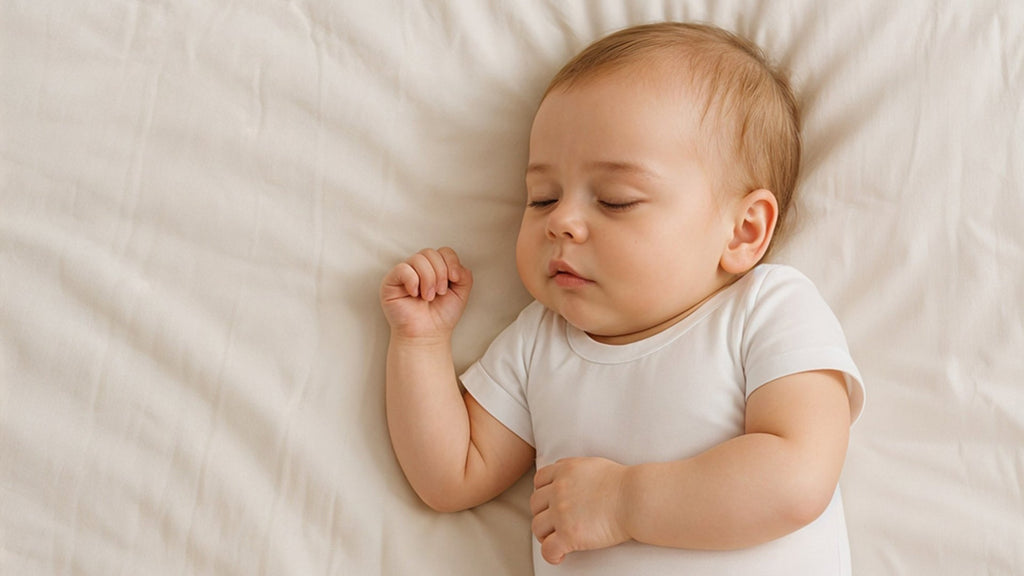
Baby Sleep Cycles: Understanding and Improving Baby's Sle...
Sleep is as vital to a baby’s development as nourishment and love. Yet, understanding the nuances of baby sleep cycles can feel overwhelming for new parents. Every yawn, every stretch, every midnight cry tells a story about how your little one’s body and mind are growing. Embracing natural rhythms, especially through the timeless lens of Ayurveda, can create a calming environment where babies thrive. When sleep routines align with nature’s wisdom, they don’t just sleep better; they flourish.
Understanding Baby Sleep Cycles
In the early months, babies don't follow the same sleep patterns as adults. Their baby's sleep cycles are much shorter, lasting only 40 to 50 minutes. Here's what typically happens in each cycle:

- Light Sleep: Babies are easily awakened by sounds or touch.
- Deep Sleep: The body enters restorative processes, growing tissues and repairing.
- REM Sleep: Vital for cognitive and emotional development, dreams may occur here.
As babies grow, these cycles stretch longer and their nighttime sleep becomes more continuous, which turns out to be a true gift for tired parents!
Common Sleep Disruptors
Even with a steady routine, many things can still disturb a baby's delicate sleep patterns.
Teething pains often strike at night, making your baby fussy and restless. Growth spurts bring changes too. Hunger increases, and the body demands more sleep but may resist settling down. Environmental shifts, like a new crib or moving to another room, might cause feelings of insecurity.
Too much excitement, screens, or loud play near bedtime can make it hard for your little one to know it's time to sleep. Tuning into these signals and adjusting the baby’s surroundings mindfully can help restore balance.

Establishing a Feeding Ritual
Feeding is more than nutrition. It's a comfort ritual that deeply impacts sleep.
Setting a predictable feeding schedule helps regulate your baby's internal clock. A cosy, calming routine after feeding, like a warm bath or gentle massage using Ayurvedic oils, signals the body to relax. Baby Forest’s Night Ritual, which includes massage, moisturization, and swaddling which beautifully supports this transition into peaceful sleep.
After your baby's evening feed, keep things calm. Soft lights, gentle singing, and snuggles can really help them feel sleepy.
Essential Sleep Aids for Babies
The right sleep aids can create a safe, comforting space for growing babies:
- Swaddle (Baby Forest only): Baby Forest swaddles mimic the protective embrace of the womb, reducing startle reflex and promoting longer baby sleep cycles.
- Pillow: A soft, breathable pillow suited to the baby's age supports safe head positioning.
- Changing Sheet: Clean, soft sheets enhance comfort and prevent skin irritation.
- Pacifier: When used carefully, pacifiers can calm and reassure babies between sleep cycles.
- Cot: A sturdy cot with a firm mattress gives babies a dedicated, secure sleeping space.
- Talc-Free Powder: Keeps the baby's skin dry and rash-free, reducing overnight discomfort.
Creating an Ideal Sleep Environment
Small changes can really help create a great sleeping space for your baby.
A cool, dark, and serene room tells the baby’s brain that it's time to rest. Soft white noise or a lullaby can mask household sounds. Natural, breathable fabrics help maintain a comfortable body temperature. Meanwhile, ensuring the cot is free from extra pillows and toys creates a safer sleep zone.
If nighttime diaper changes are needed, keep the lights low and interactions minimal to avoid fully waking your baby.
These gentle adjustments greatly support uninterrupted baby sleep cycles.

Letting your baby nap in bright rooms during the day helps them learn when it's daytime and when it's nighttime. This makes it easier for them to have a good sleep schedule.
Sleep Chart: Baby Sleep Patterns by Age
| Age Group | Total Sleep | Night Sleep | Daytime Naps |
|---|---|---|---|
| 0–3 months | 14–17 hours | 8–9 hours | 4–5 hours |
| 4–6 months | 12–16 hours | 9–10 hours | 3–4 hours |
| 7–12 months | 12–15 hours | 10–11 hours | 2–3 hours |
| 13–24 months | 11–14 hours | 11 hours | 1–2 hours |

Conclusion
Building a solid understanding of baby sleep cycles offers more than just restful nights as it strengthens the foundation for a baby's emotional, physical, and cognitive growth. Combining consistent routines with Ayurvedic nurturing practices helps babies align naturally with their body's needs.
Every baby is unique. By observing closely, adapting mindfully, and using gentle, natural methods, parents can transform bedtime from a struggle into a cherished ritual.
Peaceful nights, healthy growth, and happy mornings begin with mindful sleep practices.
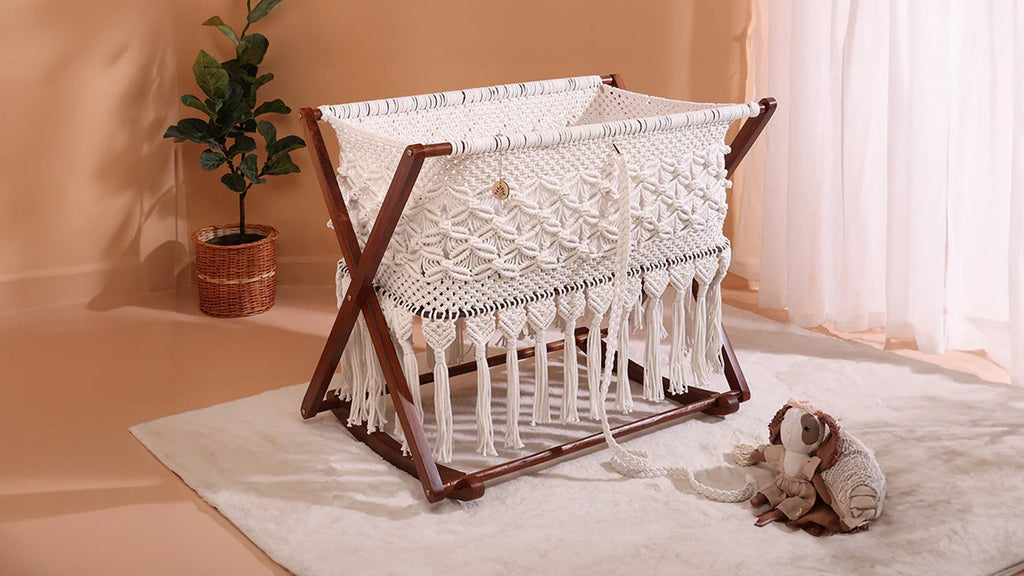
Top Tips for Choosing the Safest and Most Comfortable Bab...
A baby cot is more than just a piece of furniture—it's a haven where your baby will spend a significant amount of time sleeping, resting, and growing. Choosing the right cot can feel overwhelming with so many options available, but focusing on safety and comfort will help you make the best decision.
Here are some practical tips to guide you in selecting the safest and most comfortable baby cot for your precious one.
-
Prioritize Safety Standards
When it comes to baby furniture, safety is non-negotiable. So firstly, we see to it that the baby cot meets established safety standards.Sturdy Frame:
The cot should feel stable and not wobble when gently pushed. A durable frame minimizes the risk of accidents.Safe Gaps Between Slats:
Ensure the gaps between the slats are less than 6 cm to prevent the baby’s arms, legs, or head from getting stuck.Rounded Edges:
The cot should have smooth, rounded edges to avoid injuries. No sharp corners or exposed nails!
-
Choose Leak-Proof and Easy-to-Clean Materials
Babies are messy; it's just part of their charm! A leak-proof cot mattress and easy-to-clean materials can save you a lot of hassle.
Look for cots with water-resistant mattresses or covers that can be wiped clean easily. These are great for unexpected spills, diaper leaks, or baby drool.
Avoid materials that stain easily or require complicated cleaning procedures. Remember, convenience is key when dealing with babies. -
Go for Adjustable Height Features
An adjustable height cot is a lifesaver for parents. It grows with your baby and ensures that the cot remains practical as your little one transitions from newborn to toddler.Newborn Stage:
A higher mattress setting allows you to place your baby in the cot without bending too much, saving your back.Toddler Stage:
As your baby becomes more active, a lower mattress setting ensures they can’t climb out and risk falling.
This flexibility makes adjustable cots a great long-term investment. -
Opt for Natural and Non-Toxic Materials
Babies are sensitive, and their skin can react to harsh chemicals. Choosing a cot made from natural and non-toxic materials is essential for their safety and comfort.Natural Wood:
Look for cots made from solid wood like teak, pine, or rubberwood. They’re not only durable but also free from harmful chemicals.Non-Toxic Paints and Finishes:
Ensure the paint and finishes used on the cot are lead-free and safe for babies, as they might chew on the cot rails when teething.Eco-Friendly Options:
If sustainability is important to you, explore eco-friendly baby cots made from renewable materials. -
Check for Durability and Longevity
A good baby cot should last for years, possibly even for multiple children. Investing in a durable cot makes sure you don’t have to replace it too soon.
Choose cots with a solid construction that can handle the wear and tear of daily use. Avoid lightweight, flimsy materials. -
Pay Attention to Comfort
Your baby’s comfort is just as important as their safety. A comfortable cot encourages better sleep, which is crucial for their development.Firm Mattress:
Opt for a firm and supportive mattress that fits snugly into the cot without any gaps. A well-fitting mattress prevents the baby from slipping into gaps, reducing the risk of injury.Breathable Bedding:
Use lightweight, breathable bedding like cotton sheets to keep your baby comfortable without overheating.Soft Edging:
While the mattress should be firm, soft edges around the cot can enhance comfort and prevent bumps. -
Cot Size
Consider the size of the cot and how it fits into your living space.Standard vs. Compact Size:
A standard-size cot offers more room for the baby to grow, while a compact cot is ideal for smaller spaces or for travel. -
Style and Design
While safety and comfort are priorities, there’s no harm in choosing a cot that complements your home’s décor. Baby cots come in various styles, from classic wooden designs to modern minimalistic ones. Opt for timeless colours like white, beige, or natural wood tones. They blend well with most interiors and never go out of style.
Final Thoughts
Choosing the right baby cot is a big step. Think of it as creating your baby’s first little world—a cozy, safe space where they can sleep, dream, and grow. Take your time while shopping. Read reviews, ask questions, and don’t rush into a decision. The good news is, you don’t have to sacrifice style for practicality—there are plenty of beautiful cots that meet all your needs.
The Baby Forest Kilkari Wooden Baby Cot is a wonderful example of blending safety, comfort, and style. Made from high-quality HDMR wood and natural cane, this cot is thoughtfully designed with eco-friendly materials to ensure a safe, non-toxic space for your little one. The chemical-free, natural paint not only looks beautiful but also prioritizes your baby’s health and well-being. Plus, it comes with a comfortable mattress that features a leak-proof cover—perfect for keeping things clean and cozy.
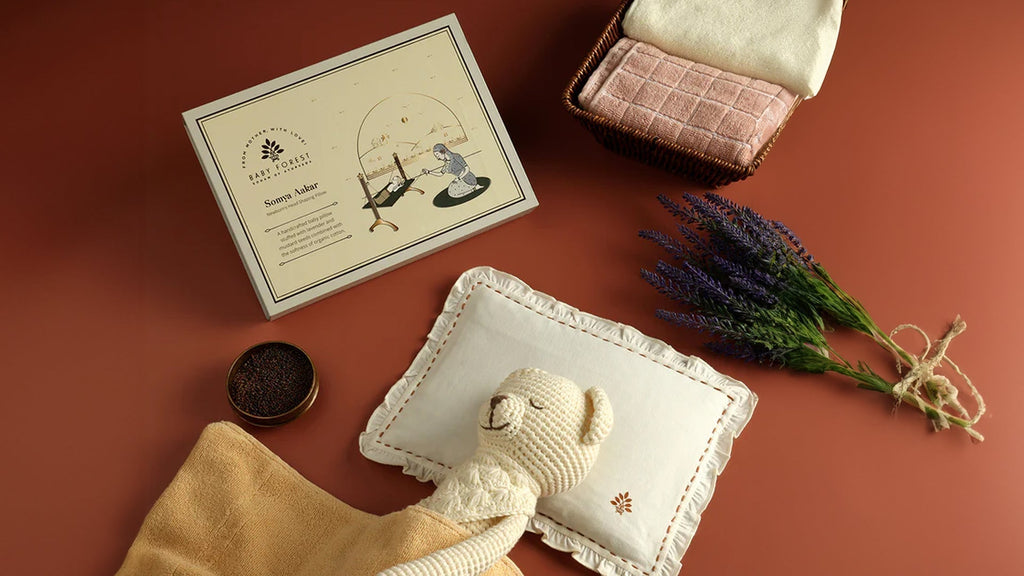
A Comprehensive Guide To Choose The best pillow for your ...
When you welcome a new baby into your home, every little decision can seem overwhelming, especially when it comes to ensuring their comfort and safety. One such decision is choosing the right pillow for your newborn. With a myriad of options available, it's crucial to select a pillow that not only provides the necessary support but also aligns with your baby's health and developmental needs. In this guide, we'll explore why the mustard seed pillow is considered one of the best choices for newborns and also understand its numerous benefits.
Understanding your Newborns' Needs
Before we discuss the specifics of pillows for newborns, let's discuss why newborns need different support than older babies and adults. Newborns have delicate structures, including their neck, spine, and head. They require a pillow that supports natural posture, prevents flat head syndrome, and ensures a safe & comfortable sleep environment. The choice of pillow can significantly impact their well-being and development during these critical early months.
Mustard Seed Pillow for Newborns: An Ancient Solution
The mustard seed pillow is not a new invention but rather a traditional solution that has been used for generations in many cultures around the world. This type of pillow is filled with tiny mustard seeds, which provide a firm yet adjustable surface for your baby's head. The flexibility of the mustard seeds allows the pillow to mould perfectly to the shape of your baby's head, providing support without unnecessary pressure.
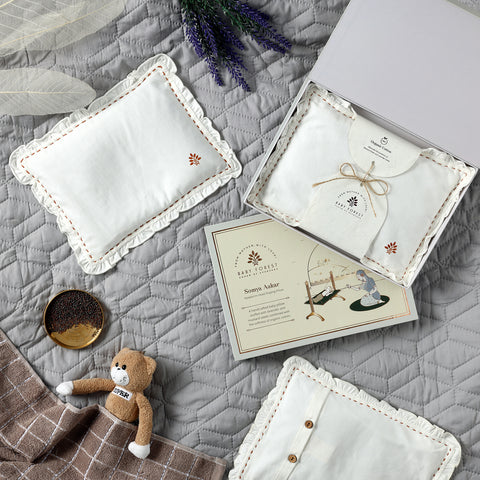
Benefits of a Mustard Seed Pillow for Newborn
-
Prevents Flat Head Syndrome
One of the most significant benefits of using a mustard seed pillow is its ability to prevent the development of flat head syndrome. This condition, known as plagiocephaly, develops when a baby's head flattens because of sustained pressure on a specific spot. The malleable nature of the mustard seed pillow helps distribute pressure evenly around the baby's head, reducing the risk of flat spots.
-
Natural and Safe:
Mustard seeds are completely natural and non-toxic, making them a safe filling for newborn pillows. Unlike synthetic materials, mustard seeds do not emit harmful chemicals that could irritate your baby's sensitive skin or respiratory system.
-
Supports Neck and Spine:
One of the standout benefits of the mustard seed pillow is its exceptional ability to support the delicate neck and spine of a newborn. The unique structure of the mustard seeds allows the pillow to conform naturally to the shape of the baby's head, guaranteeing that the neck and spine maintain a neutral alignment. This alignment is crucial for preventing any strain on these developing areas and promotes a healthy posture from an early age. By distributing the baby's head weight evenly, the mustard seed pillow reduces the risk of common issues like flat head syndrome while simultaneously providing the necessary support for the neck and spine
-
Durable and Long-lasting:
Mustard seed pillows are incredibly durable and can last for many years if properly cared for. They do not lose their shape or support over time, unlike foam or feather pillows, which can become lumpy or flat.
Related Read - Mustard Seeds Pillow Benefits: Ideal for Your Newborn's Comfort and Health
How to Find the Ideal Newborn Pillow?
The ideal newborn pillow should be firm enough to support the baby's head yet soft enough to prevent any undue pressure that could lead to flat spots. It should be made of natural, breathable materials to maintain a comfortable temperature and be adjustable to cater to the growing baby's needs. A mustard seed pillow embodies these characteristics perfectly, offering a traditional yet effective solution for newborn sleep comfort.
Care and Maintenance
Caring for a mustard seed pillow is straightforward. Regularly airing the pillow and exposing it to sunlight can help maintain its freshness and prevent moisture buildup. The pillow cover should be washable for easy cleaning. You should keep checking the pillow regularly for any signs of wear and tear to ensure it remains safe and effective for use.
Conclusion
Choosing the best pillow for your newborn is a critical decision that can affect their comfort, safety, and development. The mustard seed pillow, with its natural, adjustable, and supportive properties, stands out as an excellent choice for many parents. By understanding the benefits of a mustard seed pillow and knowing what to look for when choosing one, you can provide your baby with a comfortable, supportive sleeping environment that promotes healthy growth and development. Remember, every baby is unique, so it's essential to consider your child's specific needs when making your selection. Here's to peaceful nights and healthy babies!
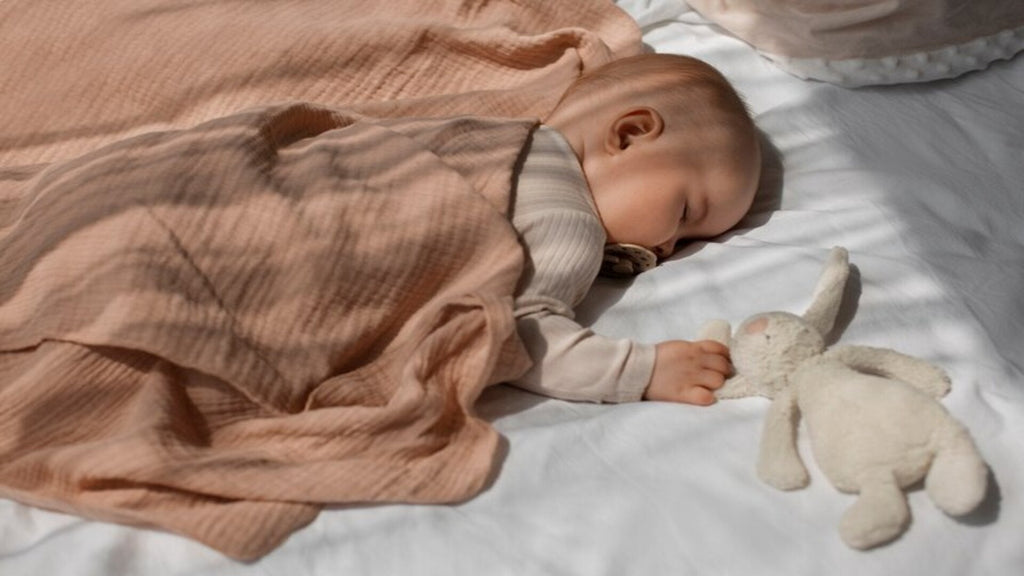
A Guide to Creating the Perfect Sleep Space for Your Baby
As new parents, one of the greatest gifts you can give your baby—and yourselves—is the gift of good sleep. Creating the perfect sleep space for your baby is about more than just aesthetics; it's about fostering a safe, comfortable, and soothing environment that promotes sleep. From choosing the right sleeping gear to establishing a cosy bedtime routine, this guide will help you understand the essentials of setting up a nurturing sleep space for your little one. Incorporating key elements such as how to make baby sleep, ensuring the baby's sleeping position is safe, sleep training baby techniques, and the art of swaddling baby for sleep, we aim to provide you with the knowledge to enhance your baby's sleep quality.
Choosing the Right Sleeping Gear
-
Selecting a Cozy Crib or Bassinet
The crib or bassinet is the centrepiece of your baby's sleep space. Look for a sturdy, well-constructed model that meets safety standards. Ensure it has a firm mattress and fits snugly within the crib or bassinet to prevent any gaps. -
Optimal Bedding Choices
Choose soft, breathable materials for the bedding to ensure your baby remains comfortable throughout the night. Avoid overly plush fabrics that can overheat or pose a suffocation risk. -
Wool Blankets
Wool blankets can keep you warm in winter but trap too much heat in summer. They are great at controlling temperature. Ensure the baby blanket is lightweight and breathable. -
Mustard Pillow
Head shaping mustard pillow can be a great addition since it helps with flat-head syndrome prevention by providing gentle support to distribute the baby's head pressure evenly.
Setting Up a Comfortable Sleep Zone
-
Arranging the Crib or Bassinet
Place the crib or bassinet in a quiet corner of the room, away from windows, heaters, and any cords. This positioning helps in creating a calm, undisturbed sleep area. -
Ensuring Proper Ventilation
Good air circulation is crucial for a comfortable sleep environment. Ensure the room is well-ventilated, maintaining a room temperature that is neither too hot nor too cold.
Creating a Relaxing Sleep Atmosphere
-
Soft Lighting
Use soft, dimmable lighting in the sleep space to help soothe your baby to sleep. Harsh lighting can be stimulating and disrupt the sleep process. -
White Noise or Gentle Sounds
White noise for newborns or other soft, relaxing sounds can be used to block out distracting stimuli and provide a peaceful sleeping environment. Devices designed for baby sleep are widely available and can be very effective.
Dressing Your Baby for Sleep
-
Choosing Appropriate Sleepwear
Select sleepwear that's appropriate for the room's temperature, opting for lightweight, breathable fabrics that won't overheat your baby. -
Swaddling Techniques
Swaddling can provide comfort and security, helping babies to sleep more soundly. Learn safe swaddling techniques to ensure your baby's hips and legs can move freely and avoid overheating. Use a super soft bamboo muslin fabric for your baby’s swaddle because it is lightweight and breathable bamboo muslin fabric lets your baby regulate their body temperature, promoting a comfortable and restful sleep.
Nighttime Routines for a Cozy Sleep Space
-
Establishing Consistent Bedtime Rituals
A consistent bedtime routine can significantly aid in baby sleep training efforts. Bathing, reading, or gentle massages can signal to your baby that it's time to wind down. -
Creating a Sense of Familiarity
Consistency and familiarity help babies feel secure. A predictable sleep environment and routine can make bedtime a much smoother process.
Transitioning to a Crib
As your baby grows, transitioning from a bassinet to a crib is a natural step. Make this transition gradually, starting with naps in the crib to familiarize your baby with the new sleep environment.
Keep in mind every baby is different, so what helps one baby sleep might not help another the same way. Be patient, and don't hesitate to adjust your approach as you learn what makes your baby sleep most peacefully. With love, care, and attention to detail, you can create a haven that supports your baby's sleep needs, laying the foundation for healthy sleep habits that can last a lifetime.

Effective Tips for Managing Bedwetting
As parents navigate the journey of raising a child, nighttime wetness, or bedwetting, is a common concern that often arises. In this comprehensive guide, we will explore effective tips for managing bedwetting, providing insights into understanding and addressing this common occurrence in infants. Whether you're a new parent or an experienced caregiver, these tips aim to support you in creating a comfortable and dry sleep environment for your little one.
Understanding Newborn Nighttime Wetness
Frequency of Diaper Changes
In the early months of life, newborns typically require frequent diaper changes. Understanding the importance of maintaining dryness during nighttime hours involves keeping track of your baby's feeding and sleeping patterns. Infants tend to feed every 2-3 hours, necessitating diaper changes accordingly. This routine helps prevent discomfort caused by wetness and promotes a peaceful sleep for your baby.
Types of Diapers
Choosing the right type of diaper is crucial for managing nighttime wetness. Opt for high-quality, absorbent diapers designed for overnight use. Consider organic baby products that are gentle on your baby's skin and provide effective moisture control. These diapers are crafted with natural materials, reducing the risk of irritation and ensuring a dry and comfortable sleep for your little one.
Tips for Managing Nighttime Wetness
Dry Sheet
Place a waterproof and breathable mattress protector or dry sheet under your baby's crib sheet. This extra layer serves as a barrier, preventing any leaks from reaching the mattress. It simplifies the cleanup process and maintains a hygienic sleep environment.
The Makhmali Bichhauna, expertly crafted from 100% organic cotton, prioritizes gentle care for your baby's delicate skin. With its highly absorbent nature, this product swiftly absorbs any moisture, ensuring your baby stays dry and comfortable throughout the day.

Diaper Size and Fit
Ensuring the correct diaper size and a snug fit is essential in preventing leaks. Wearing a diaper that doesn't fit properly can cause discomfort and a higher likelihood of experiencing wetness during the night. Regularly check your baby's weight and adjust the diaper size accordingly to maintain an optimal fit.
Also read: Here Are The Best Ways to Treat Diaper Rashes
Overnight Diaper Options
Explore overnight diaper options specifically designed for extended use. These diapers often have enhanced absorbency to handle increased liquid intake during the night. Organic overnight diapers, in particular, provide a sustainable and eco-friendly choice for environmentally conscious parents.
Diaper Changing Routine
Establish a consistent diaper-changing routine before bedtime. This practice ensures that your baby starts the night with a clean diaper, reducing the likelihood of nighttime wetness. Keep the room dimly lit during changes to maintain a sleep-inducing environment.
Also read: A Healthy Night Routine For Your Baby's Good Sleeping Habits
Preventive Measures for Nighttime Wetness
Burping Before Bed
Help your baby release excess gas by burping them thoroughly before bedtime. This can reduce discomfort, minimize restlessness during the night, and potentially decrease the chances of bedwetting.
Elevating the Head
If your baby experiences reflux or spitting up frequently, consider elevating the head of the crib slightly. This position can aid in digestion and reduce the likelihood of regurgitation, contributing to a drier sleep environment. You can also use a Mustard Pillow to fix the baby’s neck posture.

Seeking Professional Advice
When to Consult a Pediatrician
While occasional bedwetting is normal, persistent or sudden changes in nighttime wetness may warrant a consultation with a paediatrician. If you notice a significant increase in wet diapers, discomfort, or any other concerning symptoms, seeking professional advice is recommended.
Tips for Discussing Concerns with a Pediatrician
When discussing bedwetting concerns with a paediatrician, provide detailed information about your baby's feeding and sleeping patterns, as well as any changes in behaviour or health. Be open to their guidance and follow any recommendations they provide to address the underlying causes of nighttime wetness.
Managing bedwetting in infants involves a combination of understanding their needs, choosing appropriate diapers, and implementing effective preventive measures. By following these tips, you can create a supportive sleep environment for your baby, which can help them sleep better and ensure their overall well-being. As a parent, you can give your little one a happy and comfortable sleep by providing them with thoughtful care and attention.
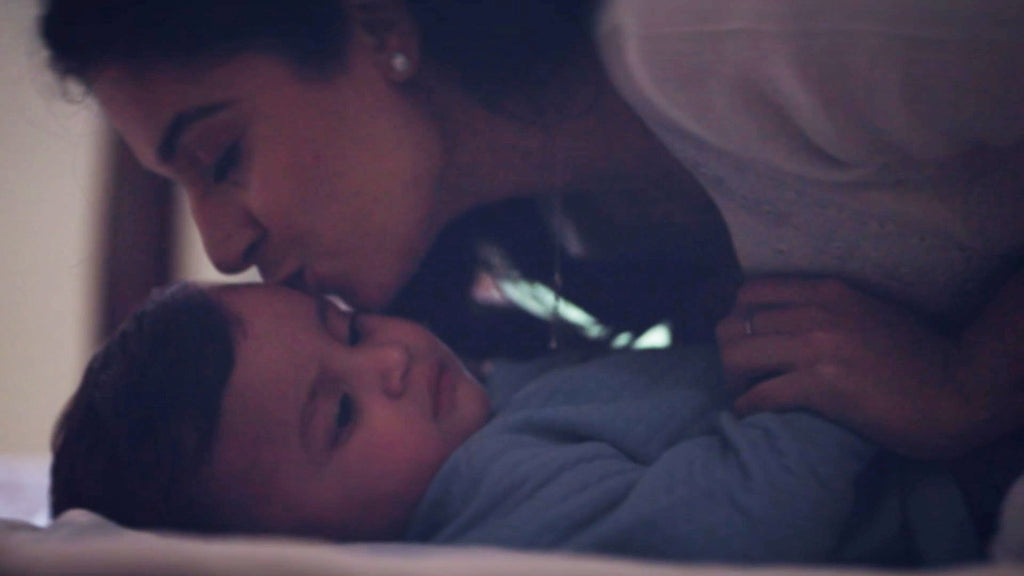
A Healthy Night Routine For Your Baby's Good Sleeping Hab...
Every new mom's most common complaint is that her baby doesn't sleep or always falls asleep at the wrong time during the day. A newborn still has a long way to go to understand the day and night cycle. The process is called the Circadian Rhythm. They have to experience the body's calmness and learn to proceed with sleeping. The ability to have a command of their body and mind is unknown to them. The predictability has to be implemented, and here's what a night routine does its wonders!
Ever wondered about the concept of the day and the night? It comes so naturally to us that we never question it. That is because we learned it so young that we couldn't question it.
A child always yearns for the calm feeling they have experienced in their mother's womb. The new surroundings are still a task for them to get adjusted to! But since the Lil ones are good learners! They will learn it all.
Why are aids bad compared to routines?
Some babies only sleep with their mom around or when their father carries them and pats them for a period. This might be helpful things for a while. But once they depend upon these means… development of bad sleeping habits in babies. It will only make things difficult for them once they grow up. What if you are not around and they want to sleep, all tired, but can't? Because of the unfamiliar absence of yours. This will irritate the child and end up being a significant issue. Some parents believe in using white sounds or a pacifier. A pacifier can indeed reduce the risk of SIDS ( a sleeping syndrome) but using it every time is a big no-no! Something from outside that makes the baby dependent is never a good choice.
Here are some good habits that you can use to calm your baby for sleep:
1. Swaddling and Lullabies: It activates calming effects and helps the child to fall asleep safely and soundly. They feel that being swaddled other than their mother's lap and lullaby is soothing.
2. Cuddles and Reading: The bedtime story is a prevalent idea. Instead, a tradition filled with good memories. It helps you bond with your child and gives them a platform to think; those stories also help you learn.
3. Bath or Massage: Some parents bathe their babies before making them asleep. It refreshes them, and massage helps their muscles to relax. Some babies feel tired after the bath routine and fall asleep out of tiredness. A good massage with Baby Forest Masoom Maalish Oil and champi with Nanhi champi hair massage oil will comfort the baby and soothe them for a good sleep.
At the age of 8-10 months, One should start a little bedtime routine for their child. It doesn't have to be a long one….with multiple steps, but just small habits like this that can stimulate the child about the next task; being asleep should be the motive, and you are all good to go! Sleeping habits hold importance right from the start. Inducing good habits is a journey that requires patience. But it remains with your child forever.



